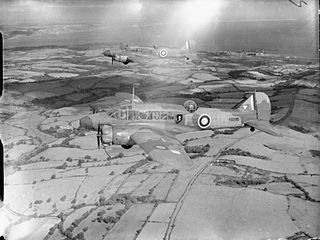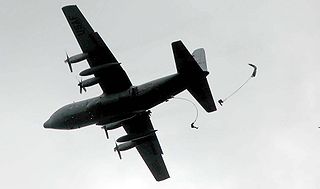
The Consolidated C-87 Liberator Express was a transport derivative of the B-24 Liberator heavy bomber built during World War II for the United States Army Air Forces. A total of 287 C-87s were delivered by Consolidated Aircraft from its plant in Fort Worth, Texas.

Number 120 Squadron or No. CXX Squadron is a squadron of the Royal Air Force which was established as a Royal Flying Corps unit late in World War I, disbanded a year after the end of the war, then re-established as a RAF Coastal Command squadron during World War II. Although disbanded again a month after Victory in Europe Day, during and after World War II it operated almost continuously, with maritime patrol aircraft; most recently with the Hawker Siddeley Nimrod, based at RAF Kinloss in Scotland until the type's withdrawal in March 2010. The squadron was disbanded again the following year. No. 120 Squadron stood up again in April 2018 at RAF Lossiemouth and became the first squadron to be equipped with the Boeing Poseidon MRA1 anti-submarine warfare (ASW) aircraft on 31 October 2019.
Royal Air Force Nutts Corner, or more simply RAF Nutts Corner, is a former Royal Air Force (RAF) station located 2.7 miles (4.3 km) east of Crumlin, County Antrim, Northern Ireland and 9.2 miles (14.8 km) north west of Belfast.
Royal Air Force Blackbushe or more simply RAF Blackbushe is a former Royal Air Force station in Hampshire, England, during the Second World War. It is now Blackbushe Airport.

Tain Air Weapons Range is a Ministry of Defence air weapons range on the Dornoch Firth near Tain in Scotland. Royal Air Force aircrews from RAF Lossiemouth are trained in air weaponry on the range, along with NATO aircrew.

No. 200 Squadron of the Royal Air Force operated during the First and Second World War. The squadron was first formed in mid-1917 and during the First World War, it undertook a training role, before being disbanded in mid-1919. It was re-formed in 1941, and operated maritime patrol aircraft firstly from the United Kingdom, and then west Africa until early 1944 when it moved to India. In April 1945, the squadron was disbanded, having been renumbered No. 8 Squadron RAF.
No. 90 Squadron RAF is a squadron of the Royal Air Force.

No. 358 Squadron RAF was a Bomber and Special duties squadron of the Royal Air Force flying with South East Asia Command from 1944 to 1945.
No. 356 Squadron RAF was a short-lived long-range bomber squadron of the Royal Air Force between 1944 and 1945.

Royal Air Force Merryfield or more simply RAF Merryfield is a former Royal Air Force station in the village of Ilton near Ilminster in southwest Somerset, England. The airfield is located approximately 7 miles (11 km) north of Chard, about 130 miles (210 km) southwest of London. It is now RNAS Merryfield and serves as a satellite to the larger RNAS Yeovilton; it is used mainly as a training facility for helicopter pilots.

No. 355 Squadron RAF was a long-range bomber squadron based in British India from August 1943 until it disbanded in May 1946. Raised for service during the Second World War, the squadron was equipped with Consolidated Liberator aircraft and carried out operations against the Japanese during the Burma campaign.
No. 357 Squadron was a special operations squadron of the Royal Air Force. During the Second World War it was involved in supplying Allied ground forces operating behind enemy lines, in the South-East Asian theatre.
No. 224 Squadron RAF was a Royal Air Force squadron that saw service in both the First and Second World Wars.

No. 321 (Netherlands) Squadron RAF was a unit of the Royal Air Force during the Second World War formed from the personnel of the Marineluchtvaartdienst (MLD), the Royal Netherlands Naval Air Service.

Royal Air Force Cheddington or more simply RAF Cheddington is a former Royal Air Force station located 1 mile (1.6 km) south-west of Cheddington, Buckinghamshire, England. The airfield was closed in 1952.

On 6 January 1954 WJ474 a twin-engined Vickers Valetta training aircraft of No. 2 Air Navigation School Royal Air Force crashed near RAF Bovingdon just after takeoff in bad weather.

On 9 November 1971, a Royal Air Force Lockheed Hercules C.1 crashed into the sea off the coast of Livorno by Meloria shoal, Italy, killing all 46 passengers and 6 crew. At the time it was described by Italian officials as the worst military air disaster in Italy in peacetime.
This is a partial list of notable accidents and incidents involving the Consolidated-designed B-24 Liberator. Combat losses are not included except for some cases denoted by singular circumstances. Consolidated C-87 Liberator Express and PB4Y Privateers are also included.

The Elvetham air crash occurred on 5 October 1945 when a Consolidated Liberator GR.VI aircraft, serial number KG867, of 311 Squadron Royal Air Force crashed at Elvetham, east of Hartley Wintney, Hampshire, following a fire in one of its engines and fuel starvation to another.












